CHEVROLET CAVALIER 1995 3.G User Guide
Manufacturer: CHEVROLET, Model Year: 1995, Model line: CAVALIER, Model: CHEVROLET CAVALIER 1995 3.GPages: 340, PDF Size: 17.09 MB
Page 11 of 340

Downloaded from www.Manualslib.com manuals search engine 0 Section 1 Seats and Restraint Systems
Here you’ll find information about the seats in your
Chevrolet and how
to use your safety belts properly.
You can also learn about some things you should
not do
with air bags and safety belts.
Seats and Seat Controls
This section tells you about the seats -- how to adjust
them -- and also about reclining seatbacks and head
restraints.
Manual Front Seat
Page 12 of 340
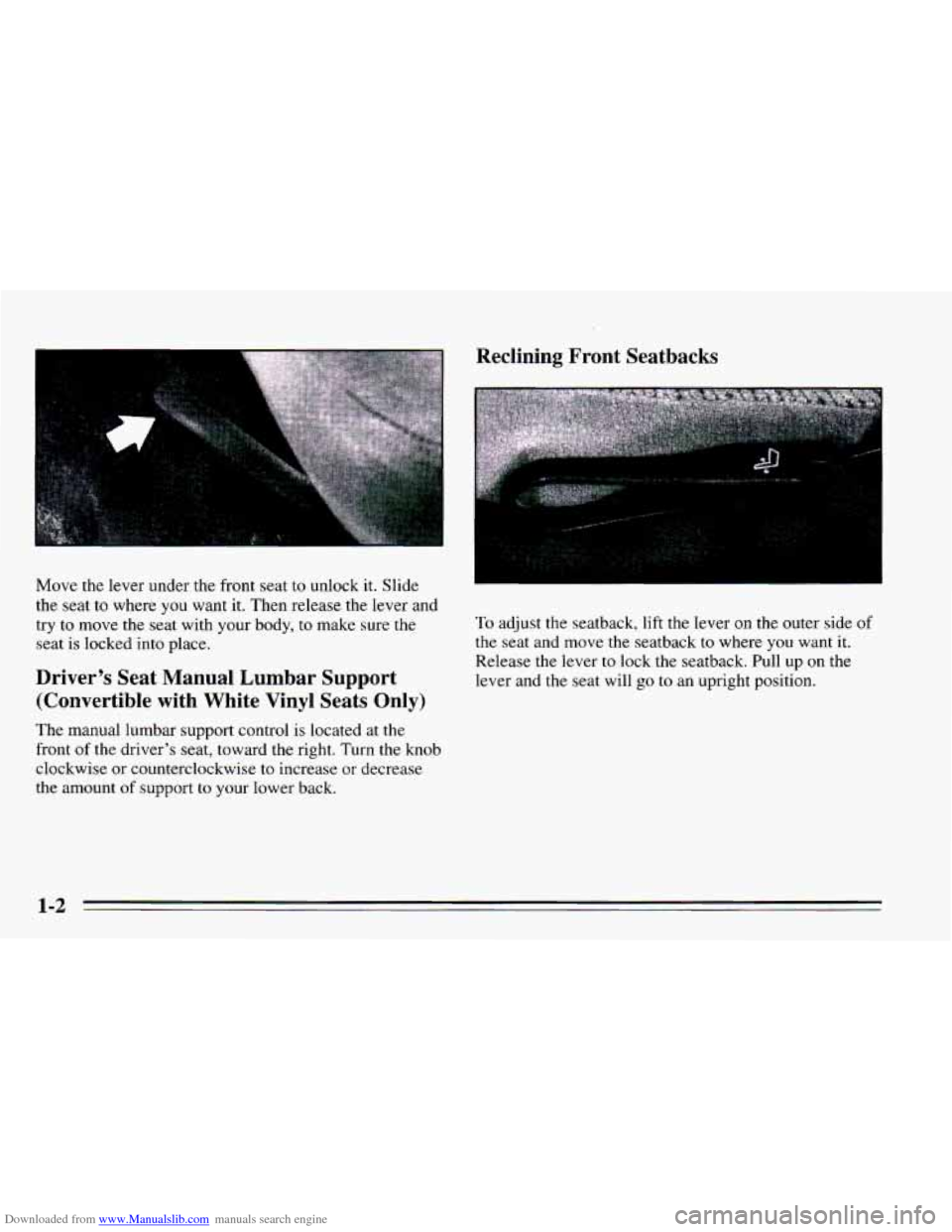
Downloaded from www.Manualslib.com manuals search engine Move the lever under the front seat to unlock it. Slide
the seat to where you want it. Then release the lever and
try to move the seat with your body, to make sure the
seat is locked into place.
Driver’s Seat Manual Lumbar Support
(Convertible with White Vinyl Seats Only)
The manual lumbar support control is located at the
front
of the driver’s seat, toward the right. Turn the knob
clockwise or counterclockwise
to increase or decrease
the amount
of support to your lower back.
Reclining Front Seatbacks
To adjust the seatback, lift the lever on the outer side of
the seat and move the seatback to where you want it.
Release the lever
to lock the seatback. Pull up on the
lever and the seat will go to an upright position.
1-2
Page 13 of 340
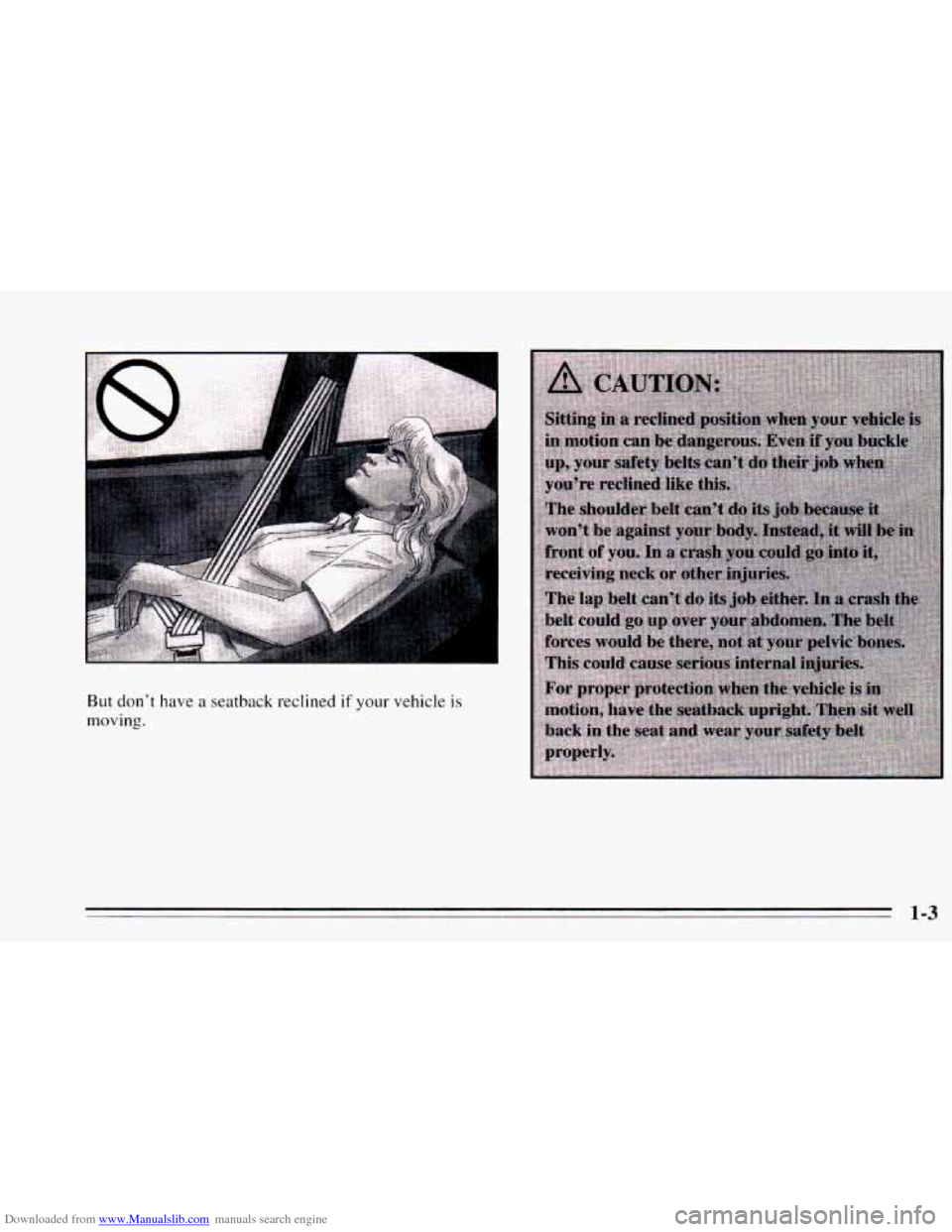
Downloaded from www.Manualslib.com manuals search engine ~ But don’t have a seatback reclined if your vehicle is
moving.
1-3
Page 14 of 340

Downloaded from www.Manualslib.com manuals search engine Head Restraints Easy-Entry Seat (Option)
Slide the head restraint up or down so that the top of the
restraint is closest
to the top of your ears. This position
reduces the chance of a neck injury in a crash.
Front Seatback Latches (2-Door Models)
On two-door models, the right front seat of your vehicle
makes it easy
to get in and out of the rear seat.
0 When you tilt the right front seatback fully forward,
the whole seat will slide forward.
After someone gets into the rear seat area, move the
right front seatback to its original position. Then
move the seat rearward until it locks.
To get out, tilt the seatback fully forwara.
Your seatback will move back and forth ‘freely, unless
you come to a sudden stop. Then it will lock in place.
There’s one time the seatback may not fold without
some help from you. That’s if your vehicle is parked
facing down a fairly steep hill.
To fold a front seatback forward, push the seatback
toward the rear as you lift this latch. Then the seatback
will fold forward. The latch must be down for the seat to
work properly.
1-4
Page 15 of 340
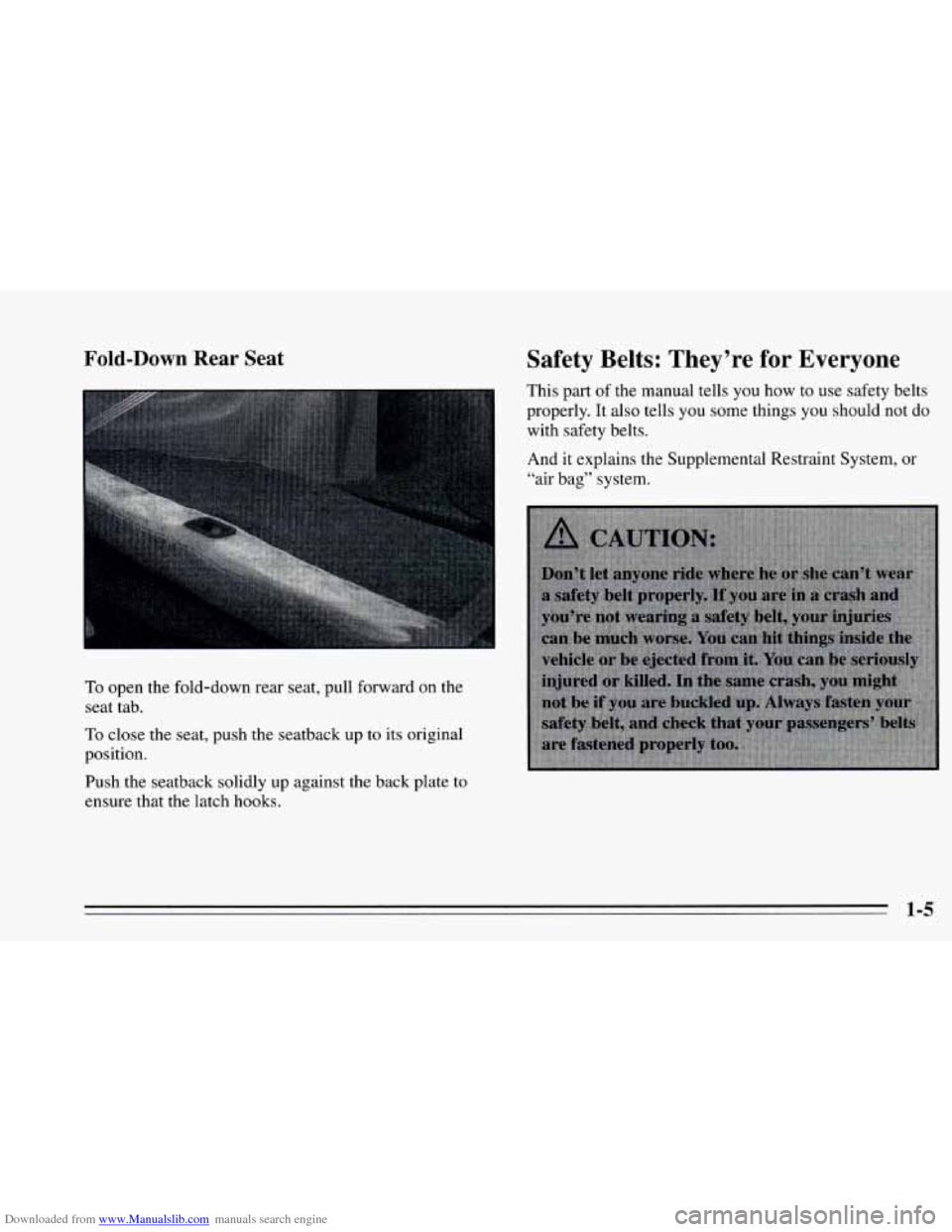
Downloaded from www.Manualslib.com manuals search engine Fold-Down Rear Seat
To open the fold-down rear seat, pull forward on the
seat tab.
To close the seat, push the seatback up to its original
position.
Push the seatback solidly up against the back plate to
ensure that the latch hooks.
Safety Belts: They’re for Everyone
This part of the manual tells you how to use safety belts
properly. It also tells you some things you should
not do
with safety belts.
And it explains the Supplemental Restraint System, or
“air bag” system.
1-5
Page 16 of 340

Downloaded from www.Manualslib.com manuals search engine Your vehicle has a light that
comes on as
a reminder to
buckle
up. (See "Safety Belt
Reminder Light"
in the
Index.)
In many states and Canadian provinces, the law says
to
wear safety belts. Here's why: They wo~k.
You never know if you'll be in a crash. If you do have a
crash,
you don't know if it will be a bad one.
A few crashes are mild, and some crashes can be so
serious that even buckled up a person wouldn't survive.
But most crashes are in between. In many of them,
people who buckle up can survive and sometimes walk
away. Without belts
they could have been badly hurt
or killed.
After more than
25 years of safety belts in vehicles, the
facts are clear. In most crashes buckling up does
matter
... a lot!
Why Safety Belts Work
When you ride in or on anything, you go as fast as it
goes.
Take
the simplest vehicle. Suppose it's just a seat on
wheels.
1-6
Page 17 of 340

Downloaded from www.Manualslib.com manuals search engine Put someone on it. Get it up to speed. Then stop the vehicle. The rider
doesn’t stop.
1-7
Page 18 of 340
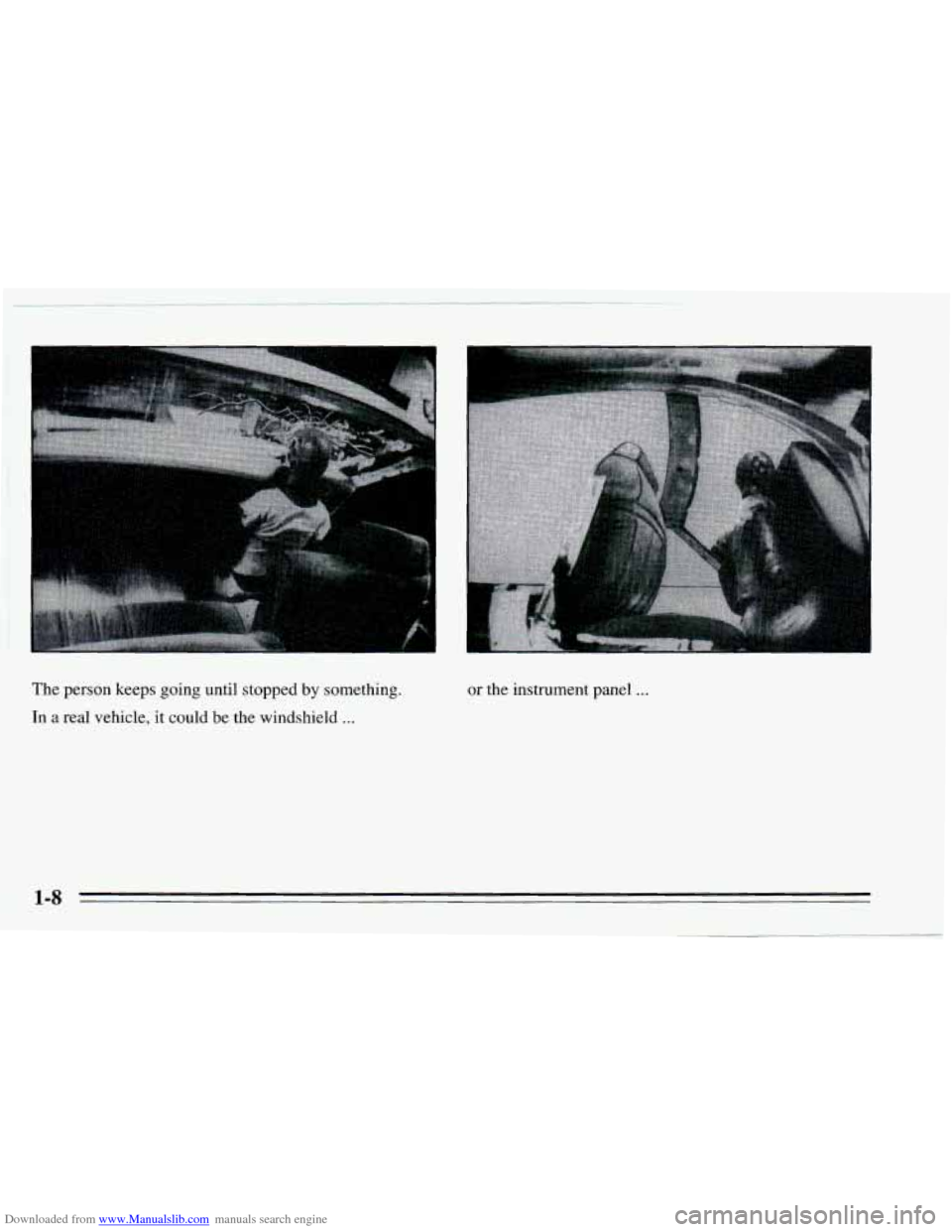
Downloaded from www.Manualslib.com manuals search engine c
The person keeps going until stopped by something.
In a real vehicle,
it could be the windshield ...
or the instrument panel ...
Page 19 of 340

Downloaded from www.Manualslib.com manuals search engine or the safety belts!
With safety belts, you slow down as the vehicle does.
You get more time to stop. You stop over more distance,
and your strongest bones take the forces. That’s why
safety belts make such good sense.
Here Are Questions Many People Ask
About Safety Belts
-- and the Answers
Won’t I be trapped in the vehicle after an
accident if
I’m wearing a safety belt?
A: You could be -- whether you’re wearing a safety
belt or not. But you can unbuckle a safety belt,
even if you’re upside down. And your chance of
being conscious during and after an accident,
so
you can unbuckle and get out, is much greater if
you are belted.
e.” Why don’t they just put in air bags so people
won’t have to wear safety belts?
A: Air bags are in many vehicles today and will be in
more of them in the future. But they are
supplemental systems only;
so they work with
safety belts -- not instead of them. Every air bag
system ever offered for sale has required the use of
safety belts. Even if you’re in a vehicle that has air
bags, you still have to buckle
up to get the most
protection. That’s true not only in frontal collisions,
but especially in side and other collisions.
1-9
Page 20 of 340
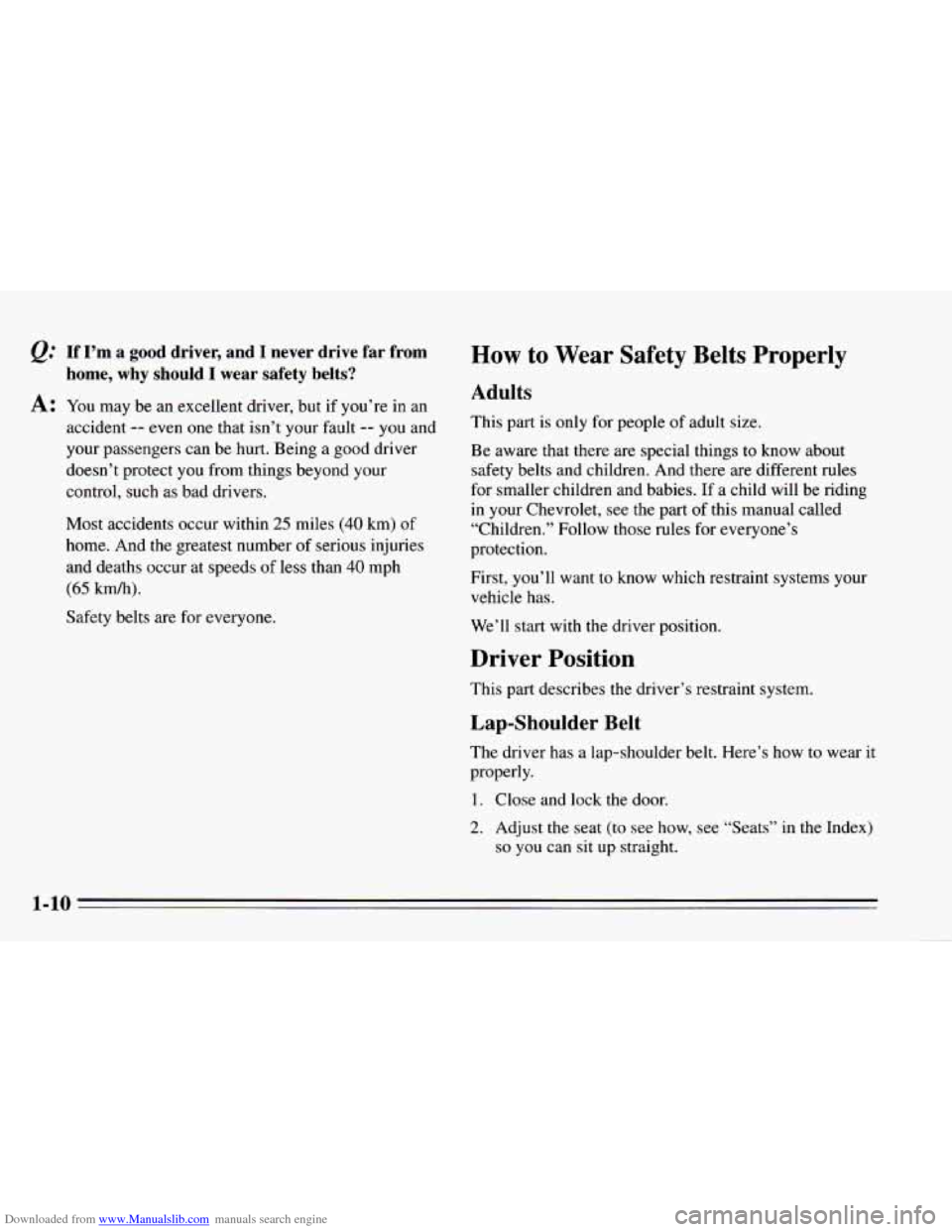
Downloaded from www.Manualslib.com manuals search engine If I’m a good driver, and I never drive far from
home, why should I wear safety belts?
A: You may be an excellent driver, but if you’re in an
accident
-- even one that isn’t your fault -- you and
your passengers can be hurt. Being a good driver
doesn’t protect
you from things beyond your
control, such
as bad drivers.
Most accidents occur within
25 miles (40 km) of
home. And the greatest number of serious injuries
and deaths occur
at speeds of less than 40 mph
(65 km/h).
Safety belts are for everyone.
How to Wear Safety Belts Properly
Adults
This part is only for people of adult size.
Be aware that there are special things to know about
safety belts and children. And there
are different rules
for smaller children and babies. If
a child will be riding
in your Chevrolet, see the part of this manual called
“Children.” Follow those rules for everyone’s
protection.
First, you’ll want to
know which restraint systems your
vehicle has.
We’ll start with the driver position.
Driver Position
This part describes the driver’s restraint system.
Lap-Shoulder Belt
The driver has a lap-shoulder belt. Here’s how to wear it
properly.
1. Close and lock the door.
2. Adjust the seat (to see how, see “Seats” in the Index)
so you can sit up straight.
1-10